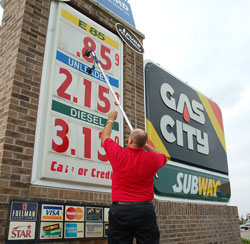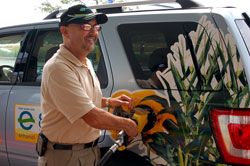 As the debate continues to rage over using some foodstuffs for fuel, there seems to be a plant that could solve the issue. The jatropha plant from Africa has been used for centuries as a natural hedge. Now, it could be a natural substitute for plants such as soybeans in the search for feedstocks for biodiesel.
As the debate continues to rage over using some foodstuffs for fuel, there seems to be a plant that could solve the issue. The jatropha plant from Africa has been used for centuries as a natural hedge. Now, it could be a natural substitute for plants such as soybeans in the search for feedstocks for biodiesel.
This story on CNNMoney.com says BP has a $160-million deal with British biodiesel producer Dl Oils to become the world’s largest producer of jatropha oil by 2011. Company officials hope to have nearly three million acres under cultivation within the next four years. That will put out about two million tons annually… the equivilant of nearly 20 percent of Europe’s forecatsed biodiesel demand:
“The deal with Dl is all about developing a biofuels business,” says BP spokeswoman Wendy Silcock. Half of the 12 countries targeted for bulk plantings are in Africa.
Because it can grow year-round in arid soil and is inedible, jatropha won’t innate food prices or take up valuable cropland. Africa is considered ideal because of its proximity to European markets and low land and labor costs. “Jatropha is low input,” says Steve Douty, executive director of Dl Oils. “It survives where others don’t. It also grows best 25 degrees south or north of the equator. A big chunk of Africa is in that band.”
The article goes on to say that the plant is good for African farmers because it grows well in poor soils, comes to maturity faster than other biodiesel feedstocks such as palm oil, and doubles as a natural fence for their livestock. It’s already popular as a source for biodiesel in other areas such as India and China, as well as the builder of a 320-million-gallon-a-year biodiesel along the Chesapeake Bay in Virginia. In addition, researchers at the University of Florida are looking at growing the plant here in the U.S. (see my post on August 31st).


 After all the excitement at the ethanol pump promotion yesterday, I have a day of calm before race weekend event frenzy. I decided to take advantage of my down time and stake out a spot in the media center at the Chicagoland Speedway. EPIC’s Director of Communications Joanna Schroeder and Marketing Director Jenny Powell popped in for a visit and hopped online. Joanna snapped this photo of Jenny and me. I’m looking forward to giving you full race weekend coverage from my newly staked out “command center.”
After all the excitement at the ethanol pump promotion yesterday, I have a day of calm before race weekend event frenzy. I decided to take advantage of my down time and stake out a spot in the media center at the Chicagoland Speedway. EPIC’s Director of Communications Joanna Schroeder and Marketing Director Jenny Powell popped in for a visit and hopped online. Joanna snapped this photo of Jenny and me. I’m looking forward to giving you full race weekend coverage from my newly staked out “command center.” National Wind, LLC has partnered with the local communities in eastern Dodge and western Olmsted counties to form High Country Energy… a partnership that will create the nation’s largest community-owned wind energy project.
National Wind, LLC has partnered with the local communities in eastern Dodge and western Olmsted counties to form High Country Energy… a partnership that will create the nation’s largest community-owned wind energy project.
 The article doesn’t directly state it, but I believe Smiling Earth Energy (check out the cool logo!) is still the one developing the project. The story does go on to say that the projetc has already received approval of the local planning commission, and the city council will consider it later this month.
The article doesn’t directly state it, but I believe Smiling Earth Energy (check out the cool logo!) is still the one developing the project. The story does go on to say that the projetc has already received approval of the local planning commission, and the city council will consider it later this month. Five departments of the City of Pocatello, Idaho are making the switch to biodiesel for their fleet of vehicles.
Five departments of the City of Pocatello, Idaho are making the switch to biodiesel for their fleet of vehicles. Ryan Hunter-Reay wasn’t the only Indy Car Driver consumers had the chance to meet at today’s ethanol pump promotion. Roth Racing Driver PJ Chesson also came out to help support ethanol. Consumers throughly enjoyed PJ antics at the gas pump. The rambunctious driver washed windshields, scribbled his name in bumper dust and even paid for one woman’s gas.
Ryan Hunter-Reay wasn’t the only Indy Car Driver consumers had the chance to meet at today’s ethanol pump promotion. Roth Racing Driver PJ Chesson also came out to help support ethanol. Consumers throughly enjoyed PJ antics at the gas pump. The rambunctious driver washed windshields, scribbled his name in bumper dust and even paid for one woman’s gas. Most customers lined up waiting for cheap gas greeted me, camera in tow, with eager smiles. Happy to be saving some cash and fueling up with ethanol I’m sure. I chatted with a few friendly faces, Les DiCarlo, Jimmy Spayer and Jim Labeau.
Most customers lined up waiting for cheap gas greeted me, camera in tow, with eager smiles. Happy to be saving some cash and fueling up with ethanol I’m sure. I chatted with a few friendly faces, Les DiCarlo, Jimmy Spayer and Jim Labeau. I think it’s safe to say that all of us a part of the ZimmComm Media crew have been eager to meet ethanol’s new driver Ryan Hunter-Reay and hear what he has to say about driving with Team Ethanol. I lucked out and got to be the first one of the ZimmComm bunch to introduce myself to the Indy Driver. Ryan stressed the importance of brining ethanol education to the community, and he says that consumer education starts at the pump.
I think it’s safe to say that all of us a part of the ZimmComm Media crew have been eager to meet ethanol’s new driver Ryan Hunter-Reay and hear what he has to say about driving with Team Ethanol. I lucked out and got to be the first one of the ZimmComm bunch to introduce myself to the Indy Driver. Ryan stressed the importance of brining ethanol education to the community, and he says that consumer education starts at the pump.
 Greetings from Chicago! Well, Joliet actually. I’m in Illinois with the
Greetings from Chicago! Well, Joliet actually. I’m in Illinois with the